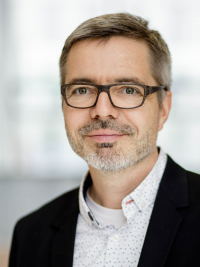Press release
Paintings on the Gable of the Friedenskirche in Frankfurt (Oder) are uncovered

The wall paintings on the east gable of Frankfurt's Friedenskirche, also known as the Nikolaikirche, which are over 700 years old, are now visible again for the first time in 650 years. A research project at the University of Applied Sciences Potsdam is analysing the existing paintings using innovative restoration and scientific methods.
Built in 1303, the mighty brick gable, which is structured with 26 blind niches, was given a colourful painting. Saints, angels and mythical creatures were depicted. Around 1370, the gable "disappeared" under the roof of the large new choir building erected at the time. Angels, phoenixes, pelicans and the figures of saints only had just under 70 years to accompany the citizens of Frankfurt in their everyday lives high above the rooftops of the city. They also directed their message of salvation far into the land beyond the Oder, as the church, appropriately orientated, lies close to the riverbank.
Hidden away like this, the paintings almost fell into oblivion. With the exception of a few black and white photographs from the 1920s from the city archives – which are based on the little knowledge available – they only came to light again in the early 1990s when the roof truss of the Friedenskirche was due for renovation. However, in order to protect the works of art, the niches were covered with chipboard during the carpentry work, so that even in the last 30 years it has not been possible to restore the entire surface or to see the paintings in their entirety.
Thanks to funding from the Ostdeutsche Sparkassenstiftung, the state of Brandenburg and the city of Frankfurt (Oder), scaffolding has recently been erected to allow access to the paintings on the gable in the roof truss and to provide practical protection in the future. At the same time, an application for funding from the University of Applied Sciences Potsdam to the German Federal Environmental Foundation (DBU) was successful, so that research into the inventory can begin using innovative restoration and scientific methods.
Together with numerous partners, such as the Rathgen Research Laboratory (SPK), the Brandenburg State Office for Monument Preservation (BLDAM), the Fraunhofer Institute Magdeburg and others, students and scientists from the University of Applied Sciences Potsdam will be working on projects over the next two years to get to the bottom of the secrets of the medieval gable. Questions of environmental pollution and the impact of the climate on the precious murals will also play a role.
Once all the work has been completed, a permanent exhibition inside the church will illustrate the gable and its history/stories – pupils from the Campus Stift Neuzelle grammar school in the region will then be the partners who want to provide a youth- and family-friendly approach to the medieval paintings and issues of monument preservation.
When the niches are opened one by one from the end of July, it was a number of steadfast players in the city of Frankfurt, the preservation of monuments in the state of Brandenburg and the University of Applied Sciences in Potsdam who ultimately made this possible. The following should be mentioned by name: Mr. Ulrich-Christian Dinse, for decades Frankfurt's city monument conservator, now retired, and Superintendent Mr. Frank Schürer-Behrmann, who is also chairman of the Ecumenical Europe Centre, which has its home in the Friedenskirche.
Contact
University Communication

